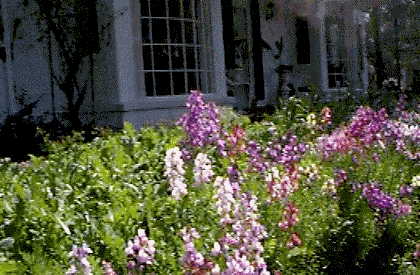 |
The Monet Garden in my yard has a story. In planting a Southern Monet Garden, one must first one must understand Monet’s theories of gardening from an artist’s perspective and then one must choose those plants from Monet’s design which will prosper in a Southern garden. I used Vivian Russell’s Monet’s Garden, Charles Prost’s The Garden of Monet, and Derek Fell’s Monet’s Garden as resource materials.
I began to understand the garden as a palette upon which Monet practiced his color theories, combining red-green-silver, blue-pink-white, yellow-violet, and orange-blue. He preferred single flowers (flowers with a single row of petals) because of their translucence when backlit and their reflective properties when front lit. The play of light upon the garden determined where a plant was planted. Cool colors appeared where the sun rose and hot colors appeared in the sunset borders.
According to Derek Fell, "The most common wayside plants in his garden were white oxeye daisies, crimson corn poppies, yellow flat iris, and wispy oat grasses. He called these plants, ‘the soul of the garden.’ The Oxeye daisies and oat grasses added to the shimmer, and the appearance of diminutive corn poppies and wavy yellow flat irises were like fluttering butterflies."Poppies and Bachelor’s Buttons Suddenly my garden took on an aesthetic dimension far beyond my original understanding of gardening. I had always responded to Impressionist art, but yet had failed to recognize the potential sensory opportunities in garden design. Monet teased the senses visually lifting the garden from the earth with arches of roses along a main pathway. Color, movement, sound, and smell all became elements to optimize the enjoyment of the little piece of the world with which God had given me to nurture.
The design plan expanded. Christie, my friend, fellow Master Gardener and mentor, sighed. She knew the immensity of our endeavor. |

Nasturtiums |
 
The Southern Monet Garden began on September 20, 1999, with bed preparation. Chris and Bryan arrived with energy, tools and a vision to begin the process of creating our Southern Monet Garden. We realized that with my sandy soil, the foundation would be critical to success. Weeding and watering would be crucial to success and enjoyment. We decided to implement the fallowing method suggested by Ed Givhan, Montgomery, Alabama physician, in his book, Conversations with a Southern Gardener. Givhan recommends preparing the bed, leaving it to lie fallow for several weeks to see which weeds will pop up. Those weeds are then zapped with Round-up. Only then are we ready to follow through on planting our seeds. Then we just sat back and wait for those weed seed to show themselves. September 21, 1999, was the day we tilled the soil after the beds had been cut in the sod.
|

Luaria |
Apply PREEN for weed control before the weeds germinate. Use a light coat, EXCEPT IN THE SEED BEDS! (We want the weeds to germinate in the seed bed so we can zap them with Round Up.) Use this once a month ALL YEAR.
Use Round Up to zap the weeds in the seed bed. Then spot spray WEEKLY. Hand weeding will still be necessary, but will be much better if taken care of with diligence.
FERTILIZE with Florikan 15-4-9 w/ Nutricote
Apply every 3-4 months (all year)
ON ALL FLOWERS AND SHRUBS
Mulch with Pine Straw. It is actually easier to place the pine straw in the bed before planting little annuals like Pansies. But not in the seed garden. Seedlings need light to germinate.
WATER, WATER, WATER, preferably in the morning |
"The sin of pride was upon me." Celestine Sibley
This is what makes gardening worthwhile. Here you see poppies, bachelor’s buttons, Queen Anne's Lace, and violas. Our lunaria continues to bloom. Unfortunately, we have had some very hard rains that have beaten down some of our beautiful flowers. We should have thinned our poppies more drastically so that air could circulate a bit more near the roots. Some that were sown in another bed actually got the dreaded "root rot" and had to be pulled up. This picture reminds one that "a thing of beauty is a joy forever." Some of these exquisite blooms resemble peonies, while others have a single row of translucent petals. Those were Monet's favorites. Monet loved to capture the light reflecting through the petal of a bloom.
The Southern Monet garden has been gorgeous with outstanding poppies. By April 22 they were turning to seed. The garden was then in transition from Spring to Fall. I pulled out many of the poppies and replaced them with cleome, touch-me-nots, and cosmos. Sunflowers will soon be planted as well. One patch of poppies, sown late, was just coming into bloom. This was a good lesson in staggered planning.
Gathering seeds is one of gardening’s greatest pleasures, especially with poppies. I spread my seed upon newspapers on an old screen in the rafters of my greenhouse so that they will dry. I then collect the seeds in paper bags and look forward to repeating the planting process --and sharing my seeds!
|